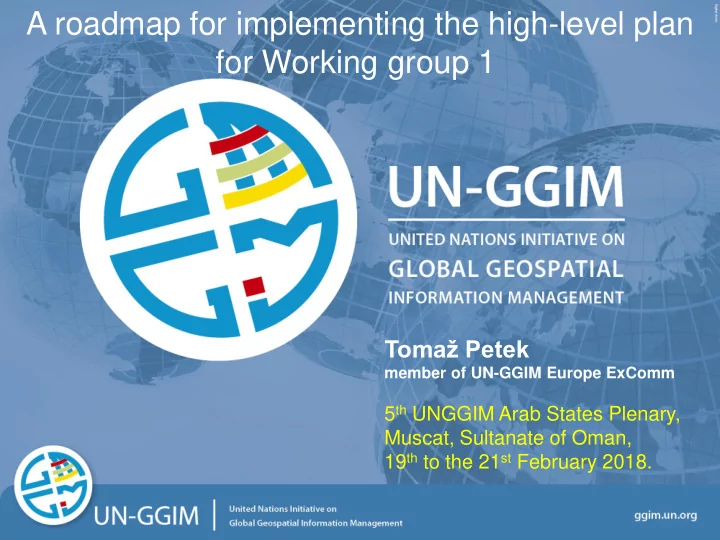

A roadmap for implementing the high-level plan for Working group 1 Tomaž Petek member of UN-GGIM Europe ExComm 5 th UNGGIM Arab States Plenary, Muscat, Sultanate of Oman, 19 th to the 21 st February 2018.
Content of presentation: • Introduction • UN GGIM and geospatial data management • UN GGIM and institutional arrangements • A roadmap for implementing the high-level plan for Working group 1 • Topics for plenary discussion • Conclusions
48 European UN Member States 10 observers http://un-ggim-europe.org/content/member-states
Extract from The Economic Impact of Geospatial Services , AlphaBeta, September 2017, https://www.valueofth eweb.com/reports/the- economic-impact-of- geospatial-services/
Fundamental datasets Overview: UN-GGIM Fundamental Data Themes 1 Geographical Names Population distribution Addresses Land Cover and Use Functional Areas Geology/Soils Physical infrastructure / service Buildings / Settlements delivery points Land parcels Water Transport Networks Ortho-imagery Elevation and depth Descriptions of these data themes can be found in Annex 3.
Framework for Interoperabolity
Susatainable Developement UN Sustainable Developement Agenda 2030
From local to regional and global level
UN-GGIM Expert and Working Groups • IAEG-SDGs Working Group on Geospatial Information • EG: Integration of Statistical and Geospatial Information • EG: Land Administration and Management • WG: Global Geodetic Reference Frame (Sub-Committee) • WG: Geospatial Information and Services for Disasters • WG: Trends in National Institutional Arrangements • WG: Fundamental Data Themes
UN-GGIM Working Group on Trends in National Institutional Arrangements in Geospatial Information Management • Identification of best practices, sets of institutional models and legal frameworks for national geospatial information management and interoperability between different systems and institutions responsible for its management, while ensuring uniformity and standardization. The institutional models should provide Governments with options on how best to create national geospatial entities • TG1: production systems of geospatial information (GI) • TG2: funding systems, dissemination and data policy of GI • TG3: the role of citizens as users and producers of volunteered geographic information (VGI) and its impact on GI systems.
National Institutional Arrangements (NIA) for Geospatial Information Management (GIM) • formal and informal cooperation structures • support and link public and private institutions and or organizations • establish the legal, organizational and productive creation, updating and dissemination, an authoritative, reliable and sustainable geospatial information base for all users.
WG1 work program
Objectives of WG1 • Goal(s) and objectives • Objective 1. Institutional Arrangements • Objective 2. Legal and Policy Issues • Objective 3. Awareness Raising and Capacity Building • Objective 4. Communications
Objective 1. Institutional Arrangements The anticipated outcomes for this objective are • Identify the NMA or other NGIM agencies from the member states • Initiate dialogue to find out their willingness and preparedness to take up UN-GGIM responsibilities • Facilitate institution building • Provide expert knowledge and access to resources • Continue engaging for UN-GGIM expansion • Understanding of the primary UN GGIM Arab States users and stakeholders, their needs and role in the UN GGIM Arab States, and • Eevaluation and prioritization of available, relevant datasets and services for inclusion into the UN GGIM Arab States.
Objective 2. Legal and Policy Issues Anticipated Outcomes • Every member state should take stock of the legal and policy documents pertaining to their country • Privacy • Data quality • Licensing / open data • Intellectual property rights • National security • Provide technical support for states in modifying the necessary legal and policy documents (Legal Issues and Economic Policy) • Operational policies that provide guidance supplementing development of Information Management Policies
Objective 3. Awareness Raising and Capacity Building Awarenes raising • Awareness campaigns among various sections of the society • People working with geospatial data • People using geospatial data • Prospective users / public • Student community • Organize awareness campaigns Capacity building • Identify the target group to be provided with training • Perform a skill gap analysis • Determine the level of training to be provided to different set of people. • Provide training and obtain feedback • Continue monitoring their performance and report to impart more training.
Objective 4. Communications The anticipated outcome for this objective: - to have a communication strategy and outreach plan to promote the benefits of UN GGIM Arab States, - to explain the operation, organization and governance - to communicate data standards and availability along with the goals of the Strategic Plan.
Action plan for WG1
Questionary
Conclusions Spatial data infrastructure at local, national and regional level: • Datasets - FRAMEWORK / THEMATIC DATA • Spatial data Services, portals - TECHNOLOGIES • Interoperability & Harmonisation - STANDARDS • Coordination of stakeholders & capacity building, legal framework - INSTITUTIONAL ARRANGEMENTS • Data policy & relation with SDG - POLICIES • ……..
THANK YOU! more info at: www.un-ggim-europe.org
Recommend
More recommend